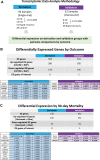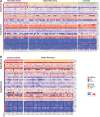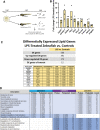DHCR7 Expression Predicts Poor Outcomes and Mortality From Sepsis
- PMID: 37332366
- PMCID: PMC10270496
- DOI: 10.1097/CCE.0000000000000929
DHCR7 Expression Predicts Poor Outcomes and Mortality From Sepsis
Abstract
This is a study of lipid metabolic gene expression patterns to discover precision medicine for sepsis.
Objectives: Sepsis patients experience poor outcomes including chronic critical illness (CCI) or early death (within 14 d). We investigated lipid metabolic gene expression differences by outcome to discover therapeutic targets.
Design setting and particitpants: Secondary analysis of samples from prospectively enrolled sepsis patients (first 24 hr) and a zebrafish endotoxemia model for drug discovery. Patients were enrolled from the emergency department or ICU at an urban teaching hospital. Enrollment samples from sepsis patients were analyzed. Clinical data and cholesterol levels were recorded. Leukocytes were processed for RNA sequencing and reverse transcriptase polymerase chain reaction. A lipopolysaccharide zebrafish endotoxemia model was used for confirmation of human transcriptomic findings and drug discovery.
Main outcomes and measures: The derivation cohort included 96 patients and controls (12 early death, 13 CCI, 51 rapid recovery, and 20 controls) and the validation cohort had 52 patients (6 early death, 8 CCI, and 38 rapid recovery).
Results: The cholesterol metabolism gene 7-dehydrocholesterol reductase (DHCR7) was significantly up-regulated in both derivation and validation cohorts in poor outcome sepsis compared with rapid recovery patients and in 90-day nonsurvivors (validation only) and validated using RT-qPCR analysis. Our zebrafish sepsis model showed up-regulation of dhcr7 and several of the same lipid genes up-regulated in poor outcome human sepsis (dhcr24, sqlea, cyp51, msmo1, and ldlra) compared with controls. We then tested six lipid-based drugs in the zebrafish endotoxemia model. Of these, only the Dhcr7 inhibitor AY9944 completely rescued zebrafish from lipopolysaccharide death in a model with 100% lethality.
Conclusions: DHCR7, an important cholesterol metabolism gene, was up-regulated in poor outcome sepsis patients warranting external validation. This pathway may serve as a potential therapeutic target to improve sepsis outcomes.
Keywords: genetics; lipids; sepsis; transcriptomics; zebrafish.
Copyright © 2023 The Authors. Published by Wolters Kluwer Health, Inc. on behalf of the Society of Critical Care Medicine.
Figures



Update of
-
DHCR7 Expression Predicts Poor Outcomes and Mortality from Sepsis.Res Sq [Preprint]. 2023 Jan 30:rs.3.rs-2500497. doi: 10.21203/rs.3.rs-2500497/v1. Res Sq. 2023. Update in: Crit Care Explor. 2023 Jun 14;5(6):e0929. doi: 10.1097/CCE.0000000000000929. PMID: 36778468 Free PMC article. Updated. Preprint.
References
-
- Gaieski DF, Edwards JM, Kallan MJ, et al. : Benchmarking the incidence and mortality of severe sepsis in the united states. Crit Care Med 2013; 41:1167–1174 - PubMed
-
- Kumar G, Kumar N, Taneja A, et al. ; Milwaukee Initiative in Critical Care Outcomes Research (MICCOR) Group of Investigators: Nationwide trends of severe sepsis in the 21st century (2000–2007). Chest 2011; 140:1223–1231 - PubMed
-
- Guirgis FW, Brakenridge S, Sutchu S, et al. : The long-term burden of severe sepsis and septic shock: Sepsis recidivism and organ dysfunction. J Trauma Acute Care Surg 2016; 81:525–532 - PubMed
Grants and funding
LinkOut - more resources
Full Text Sources
Molecular Biology Databases
Miscellaneous

